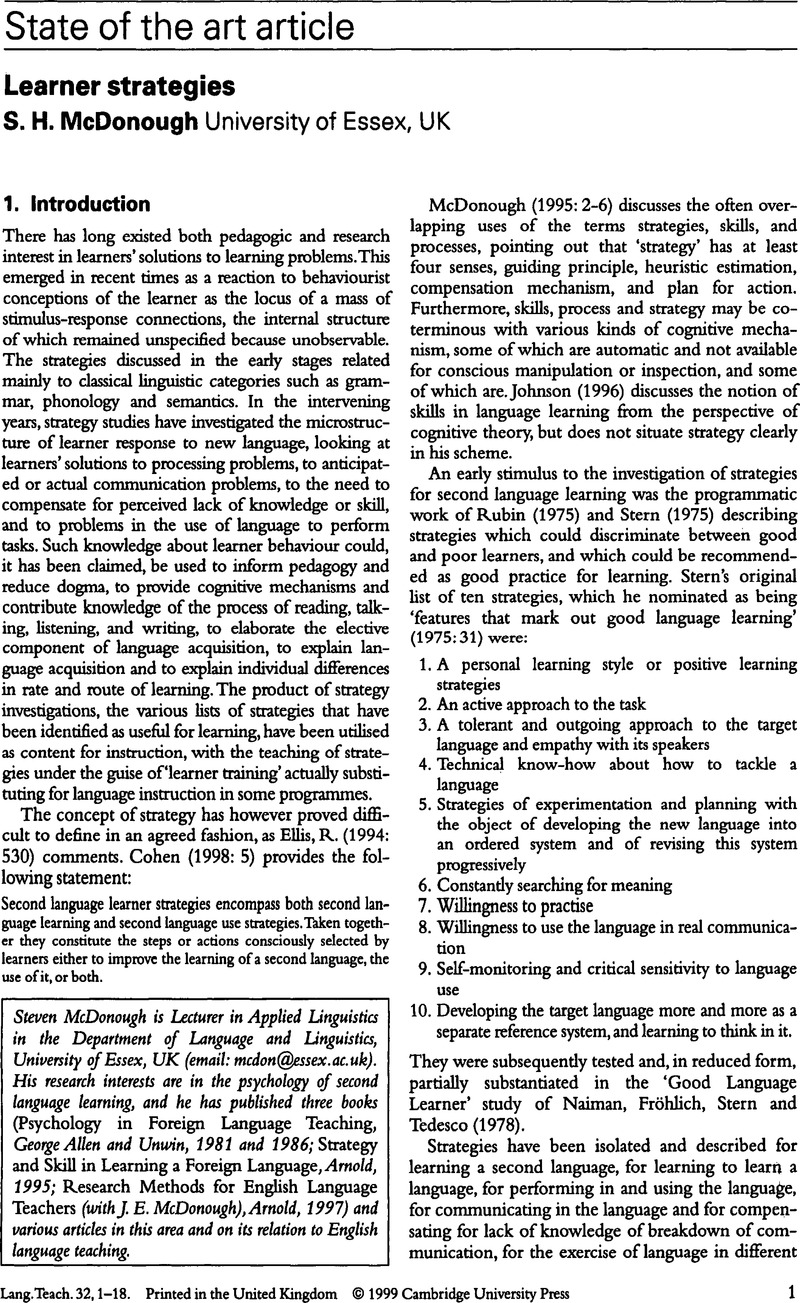Crossref Citations
This article has been cited by the following publications. This list is generated based on data provided by Crossref.
Cohen, Andrew D.
2000.
Strategies-Based Instruction for Learners of a Second Language.
NASSP Bulletin,
Vol. 84,
Issue. 612,
p.
10.
Goh, Christine C.M
2002.
Exploring listening comprehension tactics and their interaction patterns.
System,
Vol. 30,
Issue. 2,
p.
185.
Cohen, Andrew D.
2003.
The learners side of foreign language learning: Where do styles, strategies, and tasks meet?.
IRAL - International Review of Applied Linguistics in Language Teaching,
Vol. 41,
Issue. 4,
Vandergrift, Larry
2003.
Orchestrating Strategy Use: Toward a Model of the Skilled Second Language Listener.
Language Learning,
Vol. 53,
Issue. 3,
p.
463.
Petrić, Bojana
and
Czárl, Bernadett
2003.
Validating a writing strategy questionnaire.
System,
Vol. 31,
Issue. 2,
p.
187.
Littlewood, William
2004.
The Handbook of Applied Linguistics.
p.
501.
Baker, William
and
Boonkit, Kamonpan
2004.
Learning Strategies in Reading and Writing: EAP Contexts.
RELC Journal,
Vol. 35,
Issue. 3,
p.
299.
Jing, Huang
2005.
Metacognition Training in the Chinese University Classroom: an action research study.
Educational Action Research,
Vol. 13,
Issue. 3,
p.
413.
He, Tung-hsien
2005.
Effects of Mastery and Performance Goals on the Composition Strategy Use of Adult EFL Writers.
The Canadian Modern Language Review,
Vol. 61,
Issue. 3,
p.
407.
Nikolov, Marianne
2006.
Test‐taking Strategies of 12‐ and 13‐year‐old Hungarian Learners of EFL: Why Whales Have Migraines.
Language Learning,
Vol. 56,
Issue. 1,
p.
1.
Gao (Andy), Xuesong
2006.
Understanding changes in Chinese students’ uses of learning strategies in China and Britain: A socio-cultural re-interpretation.
System,
Vol. 34,
Issue. 1,
p.
55.
Tseng, Wen-Ta
Dörnyei, Zoltán
and
Schmitt, Norbert
2006.
A New Approach to Assessing Strategic Learning: The Case of Self-Regulation in Vocabulary Acquisition.
Applied Linguistics,
Vol. 27,
Issue. 1,
p.
78.
(Andy) Gao, Xuesong
2007.
Language Learning Experiences and Learning Strategy Research: Voices of a Mainland Chinese Student in Hong Kong.
Innovation in Language Learning and Teaching,
Vol. 1,
Issue. 2,
p.
193.
Harris, Vee
2007.
Exploring progression: reading and listening strategy instruction with near-beginner learners of French.
Language Learning Journal,
Vol. 35,
Issue. 2,
p.
189.
Manchón, Rosa M.
2008.
Taking strategies to the foreign language classroom: Where are we now in theory and research?.
IRAL - International Review of Applied Linguistics in Language Teaching,
Vol. 46,
Issue. 3,
Seong, Guiboke
2008.
보호영어 프로그램의 내용 수업에서 한국 아동들의 의사소통 및 학습 전략 연구.
The Korean Society of Bilingualism,
Vol. 36,
Issue. ,
p.
235.
He, Tung‐hsien
2008.
Reading for different goals: the interplay of EFL college students' multiple goals, reading strategy use and reading comprehension.
Journal of Research in Reading,
Vol. 31,
Issue. 2,
p.
224.
Zhang, Lawrence Jun
2008.
Constructivist pedagogy in strategic reading instruction: exploring pathways to learner development in the English as a second language (ESL) classroom.
Instructional Science,
Vol. 36,
Issue. 2,
p.
89.
Macaro, Ernesto
and
Erler, Lynn
2008.
Raising the Achievement of Young-beginner Readers of French through Strategy Instruction.
Applied Linguistics,
Vol. 29,
Issue. 1,
p.
90.
Ellis, Rod
2009.
Editorial.
Language Teaching Research,
Vol. 13,
Issue. 2,
p.
125.



